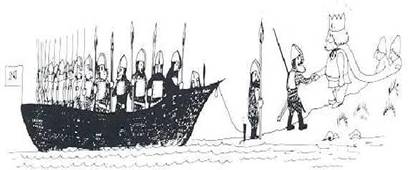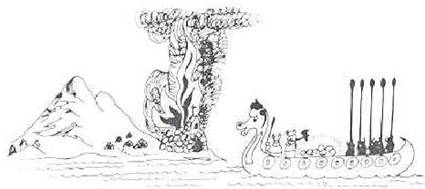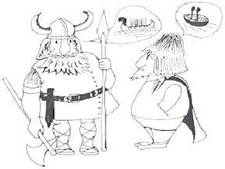|
Invaders Came in Ships |
||||||||||||||||||||||
The coming of the Danes and Norse invaders to Ireland had a lasting effect on seafaring in this country. These skilled mariners from the North of Europe brought with them their own special types of boats and ships. They used great wooden galleys driven with oars by teams of warriors. The ships had fierce-looking figureheads carved on the prows. |
|||||||||||||||||||||||
|
|||||||||||||||||||||||
| The first coming of these Scandinavians was near the end of the 8th century and it is recorded that they burnt and plundered a church on Lambay Island off the Dublin coast. They concentrated their raids on the monastic settlements which were located at river mouths and along the coasts. The intermingling of the Scandinavians and Irish increased the seafaring skills of native sailors. The Norse-Irish seafarers helped the native chieftains by carrying the country's trade to the Baltic and even to far-off Constantinople. | |||||||||||||||||||||||
|
|||||||||||||||||||||||
 |
|||||||||||||||||||||||
The coming of the Normans In 1169, the descendants of the Viking settlers in Britain came to Ireland at the invitation of Diarmuid McMurrough, King of Leinster. Two years later Henry II of England landed at Waterford. He gave port towns charters carrying certain privileges and installed English merchants and traders to ensure that the ports would remain loyal to him. The port of Dublin was given to the merchants of Bristol who came in great numbers and established the chief centre of royal power in Ireland. The end result of this was the creation of the Pale, which is so well known in Irish history. The charters gave port towns a large measure of local government and Irish trade grew with port dues bringing in money to the royal coffers. Later, under Edward III, Dublin, Waterford, Cork and Drogheda were made staple towns for wool, hides and lead and many foreign traders came to buy these commodities as local traders were not allowed to export. |
|||||||||||||||||||||||
 |
|||||||||||||||||||||||
| Did you know? | |||||||||||||||||||||||
|
|||||||||||||||||||||||




